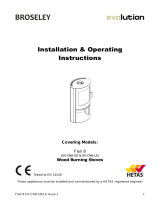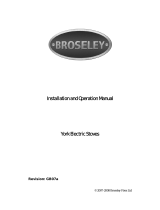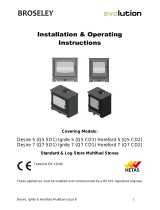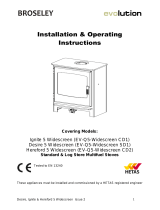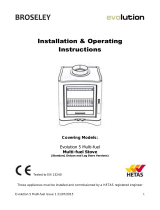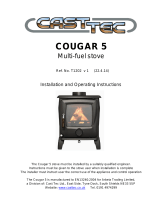Page is loading ...

Hestia EVA5/A7 Issue 1 30/06/2014 1
Installation & Operating
Instructions
Covering Models:
Hestia 5 & Hestia 7
(EV-A5-CD1 & EV-A7-CD1)
Wood Burning Stoves
Tested to EN 13240
These appliances must be installed and commissioned by a HETAS registered engineer

Hestia EVA5/A7 Issue 1 30/06/2014 2
Contents
Introduction 3
Packing List 3
Health & Safety 4
Specifications 5
Dimensions 6
Hearth Requirements & Clearances 7
Chimney Requirements 8
Combustion Air Requirements 9
Assembly 10
Commissioning/Handover 12
Stove Operation
Controls Layout 13
Controls Explained 14
Air wash System 14
Ash Pan 14
Recommended Fuels 15
Lighting the Stove
Kindling Stage 16
Burning Wood 17
Smoke Exempt Requirements 18
Lighting sequence (in smoke controlled areas) 19
Warning Notes 19
Maintenance
Ash Removal 20
Chimney Fires 20
Chimney Sweeping 20
General Stove Cleaning 20
Glass Cleaning 20
Annual Stove Service 20
Prolonged Periods of Shut-down 20
Trouble-shooting 21
Commissioning Statement 22
Spare Parts 23
EC Declaration 25
Annual Service Record 27
Warranty 28

Hestia EVA5/A7 Issue 1 30/06/2014 3
Introduction
May we take this opportunity to thank you for choosing one of our stoves?
These appliances are designed to burn wood logs and wood derived fuels. It is essential
that your wood has been seasoned to ensure that it is sufficiently dry for burning. You can
determine the moisture content of your logs by using a digital moisture meter, your logs
need to be below 20% moisture content before they are considered dry enough for
burning.
Never burn wood that contains paint, glue or any other chemicals
See the section “Lighting the Stove” for further details. After reading this document, if there
is anything you are unsure about, please contact your dealer or our Technical Support
Department.
These instructions cover the basic principles to ensure the satisfactory installation of the
stove, although detail may need slight modification to suit particular local site conditions. In
all cases the installation must comply with current Building Regulations, Local Authority
By-laws and other specifications or regulations as they affect the installation of the stove.
It should be noted that the Building Regulations requirements may be met by adopting the
relevant recommendations given in British Standards BS 8303 and BS EN 15287-1 2007 +
A1 2010 as an alternative means to achieve an equivalent level of performance to that
obtained following the guidance given in Approved Document J.
Please note that it is a requirement under the Broseley Fires warranty system that the
installation of the stove is carried out by a Competent Person registered with a
Government approved Competent Persons Scheme. HETAS Ltd operate such a Scheme
and a listing of their Registered Competent Persons can be found on their website at
www.hetas.co.uk.
Packing List
1x Steel Bodied Stove 1x Spigot
1x Rear Firebrick (5 kW) 2x Rear Firebrick (7 kW)
2x Side Firebricks 1x Grate
1x Instruction Booklet 3x Lower Firebricks (surrounding the grate)
1x Steel Ash Pan
All parts will be inside the main stove body upon delivery. The spigot may be bolted to the
outside of the stove body.

Hestia EVA5/A7 Issue 1 30/06/2014 4
Health & Safety
Special care must be taken when installing the stove such that the requirements of the Health and
Safety at Work Act are met.
Installation
This appliance MUST be installed and commissioned by a HETAS registered installer in England
and Wales and a fully qualified Heating Engineer in Scotland and Ireland.
Handling
Adequate facilities must be available for loading, unloading and site handling.
Fire Cement
Some types of fire cement are caustic and should not be allowed to come into contact with the
skin. In case of contact wash immediately with plenty of water.
Asbestos
This stove contains no asbestos. If there is a possibility of disturbing any asbestos in the course of
installation then please seek specialist guidance and use appropriate protective equipment.
Metal Parts
When installing or servicing this stove care should be taken to avoid the possibility of personal
injury.
CO Alarms
Building regulations require that whenever a new or replacement fixed solid fuel or wood/biomass
appliance is installed in a dwelling an audible carbon monoxide alarm must be fitted in the same
room as the appliance. Further guidance on the installation of the carbon monoxide alarm is
available in BS EN 50292:2002 and from the alarm manufacturer’s instructions. Provision of an
alarm must not be considered a substitute for either installing the appliance correctly or ensuring
regular servicing and maintenance of the appliance and chimney system.
Fire Guards
When using the stove in situations where children, aged and/or infirm persons are present a
fireguard must be used to prevent accidental contact with the stove. The fireguard should be
manufactured in accordance with BS 8423:2002, Fireguards for use with solid fuel appliances.
Aerosol Sprays
Do not use an aerosol spray on or near the stove when it is alight.
Stove Surfaces
It is important to note that all surfaces of the stove will become extremely hot during operation, it is
therefore highly recommended that no surface or control is touched without appropriate heat proof
gloves.

Hestia EVA5/A7 Issue 1 30/06/2014 5
Specifications
In the UK these stoves have been approved by HETAS Ltd as intermittent heating
appliances for burning wood logs only.
This product is designed and tested for intermittent use.
European standards need to be complied with when installing this
appliance.
Hestia 5 (EV-A5-CD1) Hestia 7 (EV-A7-CD1)
Nominal Heat Output
(Wood) to Room kW
5 7
Efficiency % 77.8 76.6
Weight Kg 42 53
Flue Diameter mm 125 125
Flue Diameter Inches 5 5
Flue Draft Min Pa 12 12
Flue Draft Max Pa 18 18
Operating Flue Temp °C 257 213
Flue Gas Mass Flow G/S 4.6 9.2
Wood consumption Kg/Hr 0.96 1.3

Hestia EVA5/A7 Issue 1 30/06/2014 6
Dimensions
Hestia 5
Hestia 7
ALL DIMENSIONS ARE IN MILIMETRES

Hestia EVA5/A7 Issue 1 30/06/2014 7
Hearth Requirements & Clearances
These appliances will require a full constructional hearth as laid out in Building
Regulations Approved Document J (min 125mm thick concrete sub-hearth with a
min 12mm thick non-combustible decorative top layer). The hearth must have a
sufficient load bearing capacity to accommodate the weight of the appliance
(otherwise a load distribution plate(s) must be used).
Your stove must be installed on a solid, level non-combustible hearth. The hearth
protrusion in front of the stove to carpets or wooden floors must be at least 300mm. As it is
possible, that on opening the door of the stove for fuel to fall out, a fender must be fitted if
the hearth is flush with the carpet. These are just a few hearth specifications. Please refer
to Building Regulations Approved Document J (Hearths) for more specific details.
Clearances
The stove requires the following clearances around it to ensure the heat is released into
the room and to allow sufficient combustion air flow. A combustible material clearance is
given to prevent damage to any items that may be affected by heat.
Stove Clearances
A
B
C
Above
Non-Combustible
100mm
100mm
300mm
200mm
Combustible
450mm
450mm
300mm
600mm

Hestia EVA5/A7 Issue 1 30/06/2014 8
Chimney Requirements
These appliances must not be fitted into a chimney serving another heating appliance. It is most
important that there is no obstruction in the flue or chimney. Please ensure that any existing
chimney is clear of obstruction and swept clean immediately before installation of the new stove.
Where the chimney is believed to have served an open fire previously it is possible that the higher
flue gas temperature from a closed appliance may loosen deposits that were previously firmly
adhered, with the consequent risk of flue blockage. It is therefore recommended that the chimney
be swept a second time within a month of regular use after installation.
A flue draught minimum of 12 Pascal’s to a maximum 18 Pascal’s is required for satisfactory
appliance performance. A properly built masonry or factory constructed chimney (with a minimum
vertical height of 5 metres) should ensure a consistent draught (draw). 45° bends can be used in
the flue run (maximum of four bends) you will need to add an extra 1 metre of vertical flue height
for each bend.
The flue draught should be checked under fire at high output and if it exceeds the recommended
maximum, a draught stabiliser must be fitted so that the rate of burning can be controlled, and to
prevent over firing (See section “Warning Notes”). If you have any doubts about the suitability of
your chimney, consult your local dealer/stockist or engineer. If your flue draft is below the minimum
recommendation then it may be necessary to increase the vertical chimney height, add additional
flue insulation or possibly add a special cowl to the top of the chimney (e.g. anti down draft cowl to
eliminate wind induced down draft).
The outlet from the chimney should be above the roof of the building in accordance with the
provisions of Building Regulations Approved Document J.
If installation is into an existing chimney then it must be sound and have no cracks or other faults
which might allow fumes into the house. Older properties, especially, may have chimney faults or
the cross section may be too large i.e. more than 230 mm x 230 mm. Remedial action should be
taken, if required, seeking expert advice, if necessary. If it is found necessary to line the chimney
then a flue liner suitable for solid fuel must be used in accordance with Building Regulations
Approved Document J.
If there is no existing chimney then either a prefabricated block chimney in accordance with
Building Regulations Approved Document J or a twin walled insulated stainless steel flue to BS
1856-1 can be used. These chimneys must be fitted in accordance with the manufacturer’s
instructions and Building Regulations.
If a flexible liner is required the liner diameter must not be less than 5” / 125mm.
Any bend in the chimney or connecting fluepipe should not exceed 45°. 90° bends are not
permitted. . For top flue installations it is possible to sweep through the appliance by removing the
internal baffle however it is recommended that you provide adequate access (e.g. easily accessible
soot door). For rear flue connection we recommend the use of a tee section, this should be capped
at the bottom to catch soot and debris. All joints in the connection between the stove and the
chimney must be made gastight using fire cement and where necessary fire-proof rope infill.
Please refer to British Standards BS EN 15287-1:2007 design, installation and
commissioning of chimneys for additional requirements.

Hestia EVA5/A7 Issue 1 30/06/2014 9
Combustion Air Requirements
In order for the stove to perform efficiently and safely there should be an adequate air
supply into the room in which the stove is installed to provide combustion air. This is
particularly necessary in modern houses where drafts have been almost eliminated by
double glazing etc.
Under UK building regulations any appliance over 5kW MUST have a fixed
permanent air vent (see building regulations approved document J for further
information).
There must not be an extractor fan fitted in the same room as the stove as this can cause
the stove to emit fumes into the room. It is necessary to install a wall vent to provide the
necessary combustion air and to prevent the depletion of oxygen in the room.
The above ventilation requirement is per product which means two products cannot share
one vent.

Hestia EVA5/A7 Issue 1 30/06/2014 10
Assembly
Hestia 5 (EV-A5-CD1)
The diagram below shows the stove with all internals taken out.
To install the internals simply follow the numbered sequence 1-9 and to remove simply
reverse this process.

Hestia EVA5/A7 Issue 1 30/06/2014 11
Assembly
Hestia 7 (EV-A7-CD1)
The diagram below shows the stove with all internal parts taken out.
To install the internals simply follow the numbered sequence 1-9 and to remove simply
reverse this process.

Hestia EVA5/A7 Issue 1 30/06/2014 12
Commissioning/Handover
Ensure all parts are fitted in accordance with these instructions.
On completion of the installation allow a suitable period of time for any fire cement and
mortar to dry out, before lighting the stove. Once the stove is under fire check all seals for
soundness and check that the flue is functioning correctly and that all products of
combustion are vented safely to atmosphere via the chimney terminal.
On completion of the installation and commissioning ensure that the operating instructions
for the stove are left with the consumer. Ensure to advise the customer on the correct use
of the appliance and warn them to use only the recommended fuel for the stove.
Advise the user what to do should smoke or fumes be emitted from the stove.
Upon completion of the commissioning process your installer needs to complete and sign
the commissioning statement, which can be found towards the end of these instructions
See “Commission Statement”.
CO Alarm
Your installer should have fitted a CO alarm in the same room as the appliance. If the
alarm sounds unexpectedly, follow the instructions given in section “Warning Notes” under
“Fumes”.

Hestia EVA5/A7 Issue 1 30/06/2014 13
Controls Layout
The diagram below shows the position of the two air controls, these controls need to be
operated correctly to control the combustion rate of the stove.
Secondary Air Intake
Primary Air Intake
T
The main door handle on these appliances will get hot but are removable. To remove the
handle, simply lift the main handle upwards between periods of refuelling.

Hestia EVA5/A7 Issue 1 30/06/2014 14
Controls Explained
Primary Air Intake
The primary air intake is the bottom slider situated at the bottom of the door. Having the
slider pushed to the left would indicate the intake is closed. When the slider is moved fully
to the right the intake is completely open. This particular air intake is adjustable throughout
the area left to right to control the total amount of air required for suitable combustion.
The primary air intake brings in air beneath the grate this is used on initial firing of the
stove.
Secondary Air Intake
The secondary air intake is the top slider situated just above the door. Having the lever to
the left indicates the air intake is in its minimum position. The secondary air on these
appliances is designed not to fully close, this is to meet regulations for smoke controlled
areas. Having the lever fully to the right indicates the air intake is completely open. This
particular air intake is adjustable through left to right so the slider can control the total
amount of air required for suitable combustion
The secondary air intake brings in air above the grate, this air is drawn down the inside of
the glass creating the AIRWASH system – see below. The air wash system allows the
glass to remain soot and particle free. This control is used at initial start up and when
burning wood products. Please see section BURNING WOOD.
Air wash System
Air wash is a system where secondary air is drawn into the stove (by combustion) through
the secondary air control and is deflected down the back face of the glass, thus preventing
the smoke coming into contact with the glass. It does not mean that you will never have to
clean the glass, but substantially lengthens the periods between having to do so. The air-
wash system works best when burning dry wood. Wet wood will produce more deposits
on the glass. Also, deposits will form on the back of the glass when the stove is operated
on low heat for extended periods (where fuel is only just smouldering).
Ash Pan
The ash pan should be removed when the stove is cold and not alight.

Hestia EVA5/A7 Issue 1 30/06/2014 15
Recommended Fuels
These appliances have obtained approval from HETAS Ltd., for burning –
EV-A5-CD1
Split Wood logs not exceeding 25cm in length and 10cm in diameter with a moisture
content not exceeding 20%.
EV-A7-CD1
Split Wood logs not exceeding 35cm in length and 10cm in diameter with a moisture
content not exceeding 20%.
Approval does not cover the use of other fuels either alone or mixed with the suitable fuels
listed above.
Do NOT burn wet wood,
This will give a poor heat output and will cause heavy deposits of soot and tar to
accumulate on the glass and throughout the stove and flue. The coating of soot and tar in
the chimney is volatile creating a high risk of chimney fires. A growing tree contains a high
percentage of water, the wood needs to be dried out (seasoned) before it is suitable for
burning (this can take several years). Wood logs are best stored in a stack, sheltered from
the weather, in a well ventilated area and raised off the ground. This allows the air to
circulate and prevents mildew.
Do NOT Burn Pallet Wood,
or any other wood containing glue, paint or other chemicals. This fuel will lead to damage
to your appliance. Any such damage will not be covered under the manufacturer’s
warranty.

Hestia EVA5/A7 Issue 1 30/06/2014 16
Lighting the Stove
Curing
On initial firing you will notice a very pungent odour, this is caused through the curing of
the paint, and we recommend starting with short burning sessions (with smaller quantities
of fuel) and build up gradually to allow the components of the stove to settle. Opening
doors and windows will allow the paint curing odour to dissipate and to allow ventilation
into the room. Curing times can vary but typically should take around 8-12 hours
(operation at high output) to complete.
Kindling
Stage1
With the Primary (Bottom Slider) and Secondary (Top Slider) air controls in the fully open
position and the door open, start your fire using twists of newspaper (or scrunched up
balls) or firelighters to form a bed on the grate. Place a generous amount of dry kindling
onto the newspaper and ensure their is sufficient air gaps between the kindling (a criss
cross or pyramid style pattern is ideal to accomplish this).
Kindling ---------------
Newspaper -----------
Stage 2
Ignite the paper underneath using a match or suitable fire-lighter. Allow the paper and
kindling to burn until it reduces down into hot embers. If the fire is dying during this stage
the door can be closed but not latched leaving a small gap for extra combustion air.
Stage 3
Add another generous load of dry kindling and allow to burn down.
It may be necessary to repeat stage 3 if the chimney is cold or if you find you have smoke
entering the room. This stage is vital for getting heat into the chimney which will create the
draw that takes the smoke away, we would expect this stage to take between 15-20
minutes.
It is critical that you do not leave the stove during the entire lighting and kindling
stage. See Burning wood section for the next steps in starting a new fire.

Hestia EVA5/A7 Issue 1 30/06/2014 17
Burning Wood
Once you have kindled your stove (see previous page) and your chimney (flue) is
sufficiently heated, you are now ready to start adding your logs.
Stage 4
Place 1-3 small logs onto the bed of hot embers using appropriate heat proof gloves, close
the door and reduce the Primary Air Control to approximately half way. Once the logs turn
black the primary air can be fully closed.
Stage 5
Once the smaller logs have burned down you can now add 1-2 larger ( or full size) logs
and close down the Secondary Air Intake as required. You can now control the burn rate of
the stove using the secondary air intake. You are looking for a controlled flame (not
smouldering in the embers or licking around the lid) this is mostly visual although a flue
pipe thermometer will help you determine the amount of air required and is recommended
for the initial lightings.
Stage 6
Refuel as and when required. Take care to open the door gradually as flames may lick out
and always use appropriate gloves. Try to avoid closing the Secondary air control fully (as
this will cause the stove to fill up with smoke) If you no longer want to keep the fire going
simply allow it burn out.
Warning
Do not stack wood any higher than 100mm
Extended Shutdown
If the stove is to be left unused for a prolonged period of time then it should be given a
thorough clean to remove ash and unburned fuel residues. To enable a good flow of air
through the appliance to reduce condensation and subsequent damage, leave the air
controls fully open.
It is important that the flue connection, any appliance baffles or throat plates and the
chimney are swept prior to lighting up after a prolonged shutdown period.

Hestia EVA5/A7 Issue 1 30/06/2014 18
Smoke Exempt Requirements
The Clean Air Act 1993 and Smoke Control Areas
Under the Clean Air Act local authorities may declare the whole or part of the district of the
authority to be a smoke control area. It is an offence to emit smoke from a chimney of a building,
from a furnace or from any fixed boiler if located in a designated smoke control area. It is also an
offence to acquire an "unauthorised fuel" for use within a smoke control area unless it is used in an
"exempt" appliance ("exempted" from the controls which generally apply in the smoke control
area).
The Secretary of State for Environment, Food and Rural Affairs has powers under the Act to
authorise smokeless fuels or exempt appliances for use in smoke control areas in England. In
Scotland and Wales this power rests with Ministers in the devolved administrations for those
countries. Separate legislation, the Clean Air (Northern Ireland) Order 1981, applies in Northern
Ireland. Therefore it is a requirement that fuels burnt or obtained for use in smoke control areas
have been "authorised" in Regulations and that appliances used to burn solid fuel in those areas
(other than "authorised" fuels) have been exempted by an Order made and signed by the
Secretary of State or Minister in the devolved administrations.
The EV-A5-CD1 and EV-A7-CD1 have both been recommended as suitable for use in smoke
control areas when burning wood logs when fitted with a mechanical stop preventing full closure of
the Secondary air control.
Further information on the requirements of the Clean Air Act can be found here:
http://smokecontrol.defra.gov.uk/
Your local authority is responsible for implementing the Clean Air Act 1993 including designation
and supervision of smoke control areas and you can contact them for details of Clean Air Act
requirements
Refuelling on to a low fire bed
If there is insufficient burning material in the fire bed to light a new fuel charge, excessive smoke
emission can occur. Refuelling must be carried out onto a sufficient quantity of glowing embers and
ash that the new fuel charge will ignite in a reasonable period. If there are too few embers in the
fire bed, add suitable kindling to prevent excessive smoke
Fuel overloading
The maximum amount of fuel (per hour) for this appliance is 9kg you should not exceed this figure,
overloading can cause excess smoke.
Operation with door left open
Operation with the door open can cause excess smoke. The appliance must not be operated with
the appliance door left open except as directed in the instructions.
Dampers left open
Operation with the air controls or dampers open can cause excess smoke. The appliance must not
be operated with air controls or dampers door left open except as directed in the instructions

Hestia EVA5/A7 Issue 1 30/06/2014 19
Lighting Sequence (in smoke controlled areas)
Using the approved appliance in a smoke controlled area
Ignition sequence – burning wood
For the appliance to burn cleanly, it is important to establish a hot fire as quickly as
possible. The following sequence should be followed at the ignition stage:
- Both primary and secondary air intakes should be fully open
- Light a double handful of dry kindling
- Push door to, but do not latch
- When kindling is established (takes around 5 to 10 minutes), add 2 or 3 small logs
- When the fire is established and the smaller logs have blackened, latch the door
For this sequence, it is advisable that the user be in attendance throughout.
Warning Notes
Over-Firing
It is extremely important that you do NOT leave both of the air controls in the fully open
position for extended periods or run the appliance with the door open. Leaving the air
controls fully open (or running with the doors open) will lead to “over-firing”. Over-firing is
caused when too much heat is generated within the fire chamber, this will lead to warping,
buckling and general damage to the stove and its internal components. Over-firing can
also be caused by an excessive flue draft.
PLEASE NOTE ANY DAMAGE TO THE APPLIANCE CAUSED THROUGH OVER-
FIRING WILL NOT BE COVERED BY THE WARRANTY.
Fumes
Properly installed, operated and maintained this stove will not emit fumes into the
dwelling. Occasional fumes from de-ashing and re-fuelling may occur. However,
persistent fume emission is potentially dangerous and must not be tolerated. If fume
emission does persist, then the following immediate action should be taken:-
(a) Open doors and windows to ventilate the room and then leave the premises.
(b) Let the fire go out. (c) Check for flue or chimney blockage and clean if required
(d) Do not attempt to relight the fire until the cause of the fume emission has been
identified and corrected. If necessary seek expert advice.
The most common cause of fume emission is flue way or chimney blockage. For your own
safety these must be kept clean at all times.

Hestia EVA5/A7 Issue 1 30/06/2014 20
Maintenance
Ash Removal
The ash pan can be accessed through the main door. We would recommend emptying the ash into
a metal bucket for transportation. You should only empty the ash when the appliance and ashes
are completely cool and can be disposed of in your normal household refuse.
Cleaning the Stove
We recommend only doing this when the stove is cold using a soft brush to clean any of the stove
surfaces, this is normally sufficient to remove dust, ash and debris. For stubborn marks you can
use a damp lint free cloth, ensure that all surfaces are dried off immediately. We do not
recommend using any kind of chemicals or abrasive materials. It is possible to touch up the paint
using the original metallic black stove paint, however this new paint will then need to cure.
Glass Cleaning
A damp lint free cloth is normally sufficient, however for stubborn build ups we would recommend
using a very fine wire wool.
Chimney Sweeping
It is essential that your chimney (flue) is swept at least once a year by a registered professional
chimney sweep. Sweeping removes particles that could otherwise fuel a chimney fire, it should
also highlight any potential issues such as leaks and damage to the flue.
Where the chimney is believed to have served an open fire previously it is possible that the higher
flue gas temperature from a closed appliance may loosen deposits that were previously firmly
adhered, with the consequent risk of flue blockage. It is therefore recommended that the chimney
be swept a second time within a month of regular use after installation.
Chimney Fires
In the event of a chimney fire ensure both Primary and Secondary air controls are fully closed and
the door(s) remain closed at all times. If the chimney fire does not go out or if there is a serious risk
to people and property, call the fire brigade immediately.
Regular sweeping of the chimney will remove combustible particles and will reduce the risk of
chimney fires.
Stove Servicing
Your stove should be inspected annually to ensure all seals are present and correct and to gauge
the condition of the internal components. The service should be done by a HETAS registered
engineer who also perform a spillage test and ascertain the correct functioning of the plumbing
circuit.
Prolonged Periods of Shut-down
If the stove is to be left unused for a prolonged period of time then it should be given a thorough
clean to remove ash and unburned fuel residues. To enable a good flow of air through the
appliance to reduce condensation and subsequent damage, leave the air controls fully open.
It is important that the flue connection, any appliance baffles or throat plates and the chimney are
swept prior to lighting up after a prolonged shutdown period.
/

